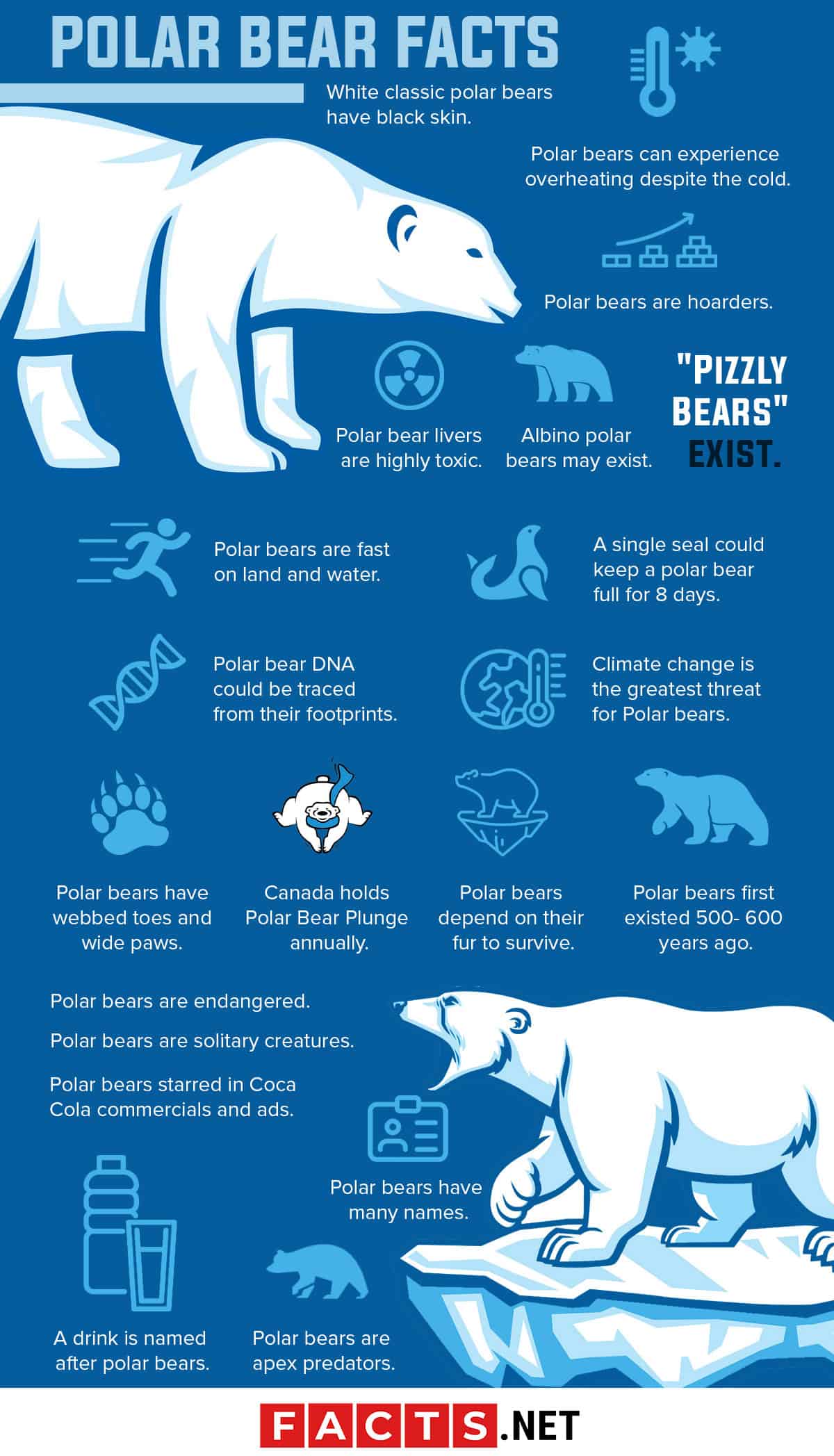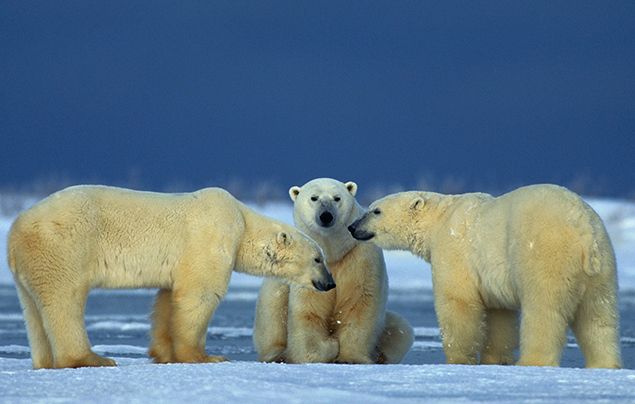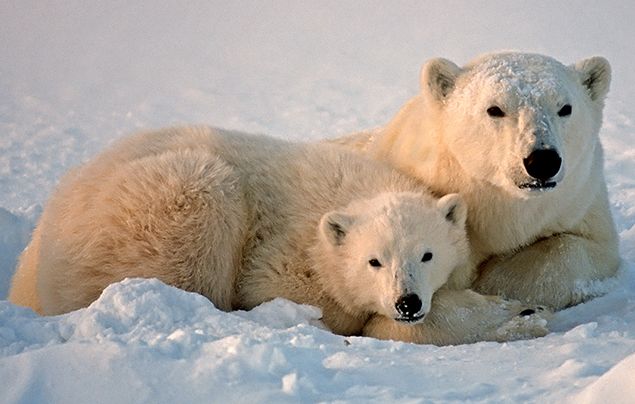The scientific name of the polar bear is Ursus maritimus. Turns out theres a surprise under all that bright white fur.

10 Facts About Polar Bears National Geographic Kids
Polar Bears live a solitary lifestyle with only mother and cubs staying together for any length of time.

10 short interesting facts about polar bears. This is very effective because it camouflages the polar bear in the snow and its prey is not able to see it. Ten fun facts about Polar bears. 10 freezing facts about the polar bear that you probably didnt know 1.
Polar Bears Evolved from Brown to White for Camouflage Perhaps the most obvious of polar bear facts is that they are. Animal facts teach us that in all species of bear the male is larger than the female on average. 2 These are seriously big bears gang.
Although polar bears appear white to the eye their fur is actually transparent. 3 Polar bears are well adapted to survive in one of the. Contrary to popular belief polar bears actually have black skin which can be seen on their snouts.
Polar bears are one of the most amazing animals that have ever lived on the earth. A polar bears closest relative is the brown bear. Female polar bears weigh about 150 to 250 kg 330 to 550 lb and are about 18 to 25 m 6 to 82 ft long.
Under their fur polar bear skin is actually black. You should know that polar bears are the largest living carnivores in the world. Polar bears will usually become between 180 and 265 centimeters.
The polar bears babies are much smaller than human babies when theyre born. Fun and Interesting Facts about Polar Bears. Are Polar bears sociable.
Kodiak bears and polar bears are the largest bears. The polar bear is the largest land-dwelling carnivore. 10 Facts About the Polar Bear 1.
The polar bear is the most carnivorous member of the bear family feeding mainly on a diet of ice seals. But some biologists think that polar bears diverged from brown bears as early as 600000 years ago. Their diet consists predominately of bearded and ringed seals but they also eat walrus bowhead and beluga whale carcasses birds eggs and sometimes vegetation.
Polar bears are classified as vulnerable by the IUCN because their. Because they spend most of their lives on the sea ice of the Arctic. Polar bears are classified as marine mammals.
While most bears live in forests the polar bear lives in the icy conditions of the Arctic. 18 Interesting Polar Bear Facts You Probably Didnt Know. Polar bear fur is translucent and only appears white because it reflects.
July 24 2021 December 5 2020 by Tom. However there have been registered certain individuals up to 295 centimeters. It only appears white because it reflects visible light.
With an incredible sense of smell polar bears can track seals from some 16km away. For centuries polar bears have been an important part of many cultures. The female bear will typically be half the size of the male.
Perhaps the most obvious of polar bear facts is that polar bears are white. Male polar bears are twice as big as females. Brown bears can be equally hefty when it comes to mass but polar bears are much taller they can reach heights of up to 10 feet.
To survive in their icy habitat polar bears have a number of fine-tuned features. Moreover this acts as an insulation and helps keep the polar. Top 10 facts about polar bearspolarbears polarbear polarbearfacts facts factsaboutpolarbears animals bears bear top10 polar nature arctic intere.
Although polar bears appear white to the eye their fur is actually transparent. Polar bears are stocky with a long neck relatively small head short rounded ears and a short tail. Polar bears have very good swimming ability and can swim a very long distance without any halt.
Polar bears are stocky with a long neck relatively small head short rounded ears and a short tail. They have been featured in many books TV shows and movies. Their Habitat Is Largely Affected by Oil Spills.
Their front paws are large flat and oar-like which also helps. They Have Black Skin. With an increasing amount of offshore petroleum installations and.
The oldest known polar bear fossils hail from Svalbard and northern Norway and are dated at 115000130000 years old before the beginning of the last Ice Age. Polar Bears are powerful predators that often do not fear humans which can make them dangerous especially since the sea ice is disappearing and prey is scarce and hard to catch. Polar bears have black skin and colorless hair.
The polar bear is an excellent swimmer and can swim for days. The Hair and. They can swim.
Polar Bear Facts 10 Interesting Facts about Polar Bears. 1 Polar bears are found in the frozen wilds of the Arctic in Canada Alaska US Greenland Russia and Norway. Male Polar Bears Have Longer Hairs on Their Front Legs for Mating.
Pregnant females can weigh as much as 500 kg 1100 lb. Male Polar Bears Have Longer Hairs on Their Front Legs for Mating One of the surprising polar bear facts. Are Polar bears dangerous.
Males normally weigh between 775 and 1200 pounds while females pack on between 330 and 650 pounds. Sixty percent of the 19 polar bear sub-populations are in Canada. They are extremely good long-distance swimmers.
Their hollow thick coat reflects light to give a whitish color on their skin. Polar Bear Facts and Information for Kids. Polar bears are actually black not white.
10 Interesting Facts about Polar Bears You Might Not Know 1. So to find them you will have to go to Canada Alaska Russia Greenland and Norway. Polar Bears Evolved from Brown to White for Camouflage.
Polar Bears Are Patient. Adult polar bears can measure over 25m long and weigh around 680kg. Polar Bears Spend More Than 50 of Their Time Hunting.
1 of 10. They have partially webbed forepaws that help them speed through the water at speeds reaching six miles per hour. Pregnant females can weigh as much as 500 kg 1100 lb.
A grown-up male polar bear can become up to 800 kilos but averages at 300-600 kilos. An adult polar bear can measure up to 25 cm long and can weigh up to. Polar Bears Are Classified as Vulnerable.
It only appears white because it reflects visible light. Top 10 facts about polar bears 1. Polar bears are generally found in frozen wild parts of the Arctic.
There is a wider range of sizes between the different bear species. Their long neck and narrow skull probably aid in streamlining them in the water while warming the air that they breathe. Polar bears need to consume a huge amount of fat to survive.
Polar bears are excellent swimmers and can sustain a pace of 62 miles per hour by using their front paws like oars while their hind legs are held flat like a rudder.

50 Adorable Polar Bear Facts That You Never Expected

10 Facts About Polar Bears National Geographic Kids

Interesting Facts About Polar Bears Educational Video For School Learning Youtube

10 Polar Bear Facts For Kids Polar Bear Facts Bear Facts For Kids Polar Bear

7 Fun Facts About Polar Bears Bear Facts For Kids Learning Colors Arctic Snow Funny Sock Puppet Youtube

10 Facts About Polar Bears National Geographic Kids